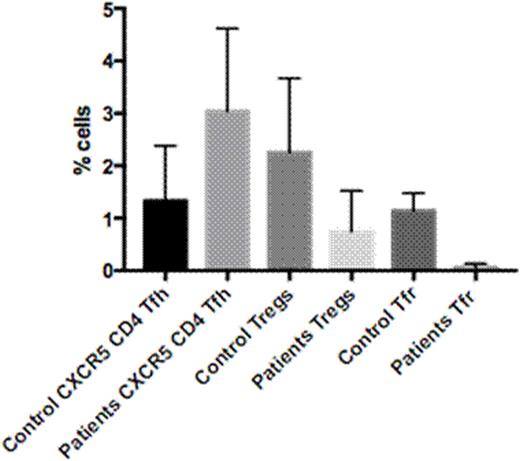Abstract
Introduction:T-follicular helper cells represent a sub-population of CD4+helper T cells (TFH), and they are characterized by the surface expression of CXCR5, ICOS, and PD1, the transcription factor Bcl-6, and produce mainly IL-21, but also IL-17, IL-4, and IFN-γ. They represent the major population that helps B cells to turn into plasma cells and they are implicated in the pathogenesis of different autoimmune diseases. Peripheral CXCR5+CD4+ T helper cells (p-TFH) are the circulating component of TFH. p-TFH cells have been extensively studied in the context of inflammation and autoimmunity. Patients with systemic lupus erythematosus and rheumatoid arthritis have increased p-TFH. T follicular regulatory T cells (Tfr) express CXCR5, ICOS and PD1, CD25 but also FOXP3, and they can inhibit B cell responses.
Immune dysregulation characterizes patients with aplastic anemia. We and others have previously shown that aplastic anemia patients have decreased levels of regulatory T cells (Tregs) at presentation and increase if they respond to treatment. Additionally, these patients display increased Th17 cells at presentation.
Specific aim: In this study we wanted to examine the expression of p-TFH and Tfr cells in patients with aplastic anemia. We isolated peripheral blood mononuclear cells (PBMCs) from patients with aplastic anemia (n=8) and ten healthy, age- matched controls. Written informed consent was obtained from all study subjects. PBMCs were left untreated or activated with PMA and Ionomycin, in the presence of Brefeldin A, for 5 hours. Subsequently, cells were stained with the surface markers CXCR5, CD4, CD57, CD25, CD127, CD278, CD279, IFN-g,IL-21, and IL-17, and subsequently analyzed by flow cytometry.
Results: Patients with aplastic anemia showed increased expression of CD4+CXCR5+ cells (Tfh) compared to healthy controls (3,03±0,55% vs 1,3±0,52% respectively, p=0.08). Additionally, these patients also showed decreased expression of Treg cells compared to healthy controls (0,74±0,27% vs 2,25±0,70% respectively, p=0.03). When analyzed for Tfr cells, patients with aplastic anemia showed minimal levels of these cells compared to helathy controls (0,05±0,02% vs 1,14±0,16% respectively, p<0.001) (Fig. 1).
Conclusion: Although the number of patients analyzed is limited, our preliminary results suggest that aplastic anemia patients show increased CXCR5+CD4+ cells compared to age-matched control subjects, and decreased Tfr cells. Further analysis of a larger pool of subjects is underway along with the examination of the specific transcription factor Bcl-6, to reveal the role of p-TFH and Tfr cells in the immune pathogenesis of aplastic anemia.
No relevant conflicts of interest to declare.
Author notes
Asterisk with author names denotes non-ASH members.


